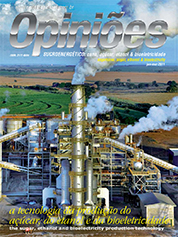Pedro Luiz de Arola Pedrosa
Independent Specialist Consultant on Preparation and Milling
Op-AA-27
Progress and diversification
Among the operations that comprise the sugar and ethanol production system, the one that requires a lot of attention to detail, due to the multitude of existing options for putting together its components, is extraction. In order to analyze it, it is important to study the two phases it comprises: preparation and crushing.
Preparation: In the beginning, the crushing mill, called a three roller mill, consisted of three vertical cylinders, through which all the whole stalk sugarcane passed. After 1920, when cylinders began operating horizontally, a rotative knife was introduced. The basic idea was to pre-crush the cane somewhat, to facilitate the operation of the mills.
In doing so, one discovered that the more open the fibers were, the easier it was to extract saccharose. Subsequently, a system was developed, known by the name K-4, comprising two knife sets, the first being a leveler and the second, a preparer. More recently, one added a set of oscillated knives, using hammers.
Although this system was adopted, the cane still had pieces larger than was wanted. Then, technicians sought to produce smaller pieces, to better expose the saccharose. Shredders were developed, machines specifically designed to open sugarcane fibers. Experimenting with different types of shredders took place. Usually, they were positioned right after the first three roller mill or crusher.
Nowadays, shredders developed in South Africa, such as the Tongaat, are being used on a grand scale, along with a similar model manufactured in Brazil, the DH-1. By combining several equipment units, one can reach an open cell rate of 90 to 92% and a saccharose extraction rate of 96 a 98%, using welldimensioned and well-operated tandem equipment.
One should bear in mind that there is a limit for the cell preparation rate, and that after reaching it one simply consumes machine power without any gain from opening the cells.
Crushing: Over time, many changes were made on the crushing mills, seeking more efficiency and to increase its resistance in light of a new work scheme.
One of the first accessories to be developed was a press and feeder roller, known by its type name “Senado”. Implemented in 1942, even nowadays it is widely used. In the 1930’s, the Werkspoor company added a small feeding roll above the one at the entrance and in front of the upper one.
This same idea was adopted by Fives-Lille, also on the self-regulating F-63s. In the 1970’s, the Africans developed the Feed Pressure Roll, whose diameter reached up to 80% of that of the crushing mill rolls and had a 20% higher peripheric speed. Today, they reach 100% of the mill diameters.
Diffuser: With the coming about of saccharose extraction from beet, other kinds of equipment were developed, given that beet has no fibers, only starch. Thus, the diffuser was developed, which extracted saccharose from a fiber bed on a conveyor.
Because it is equipment easy to operate, with simpler and cheaper maintenance, several engineers tried to adapt it for the production of sugar and sugarcane. Initially, there were several problems, including the fact that in the extraction, much non-sugar material was also extracted, mainly salts and potassium salt, which inhibits the crystallization of sugar.
Apart from the extraction of salts, the addition of lime in the process dissolves pectin, which has a disastrous effect on cooking and turbines, beyond the generation of other chemical problems, which are the dissolution products that render crystallization impossible.
With some of the problems solved and while achieving extraction of more than 98% (average bagasse pol of 0.8), the Diffuser became a serious contender of crushing mills for the production of ethanol. Another limiting factor for use of the Diffuser on a grand scale is the fact that its flexibility in varying crushing is more reduced than in the case of crushing mills.
Nowadays, with the expansion of ethanol, all this additional volume of molasse resulting from the sugar production process is used for the production of ethanol, actually with higher yields of ethanol per ton of molasse. The major advantage of the cane Diffuser (and even of the crushing mills) in comparison with sugar mills, is the fact that beet has no fibers, resulting in that heavy oil is burnt in the process of making sugar and ethanol.
In view of such great diversity, in my opinion, one of the best options to put together an ideal set, both from the operational point of view and the perspective of maintenance easiness, along with the achieved results, would be to use five crusher sets comprising four drums each, driven by hydraulic or electric motors with planetary gears, equipped with a Donnelly chute, and preceded by two sets of levelers and preparer knives, in addition to a heavy shredder of the vertical type (Tongaat).




